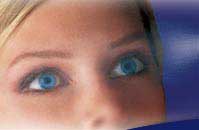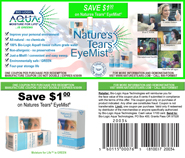
Contact Lens Dry Eye - The All-Natural Solution
Contact Lens Discomfort may be Caused by Dry Eye, and by Water Loss in the Eyes' Tear Film
Contact lens dry eye.
As technologically miraculous as modern contact lenses are, too many people are still only able to wear them for short periods, while many others cannot tolerate them at all. A primary reason for contact lens discomfort is a condition called "contract lens dry eye." Even for those who tolerate contact lenses reasonably well, the lenses often cause discomfort that can increase over time.
This is unfortunate because for 28 million people, contact lenses make the difference between seeing clearly in all directions or confinement to inconvenient and distorting eyeglasses. With the many contact lens choices available these days, they should provide an invaluable benefit to millions with poor eyesight.
The good news is that for those with low contact lens tolerance, or who suffer from contact lens dry eye, there are now ways to minimize the discomfort
The amazing tear film.
Contact lenses (both hard lenses and soft lenses) float on the surface of the delicate and complex tear film that covers the exposed parts of the eye, and rely on the tear film's natural moisture (water) to maintain their pliability, integrity and adherence. Surface tension of the tear film's moisture prevents the lenses from falling out.
The problem is that contact lenses deplete the tear film's moisture content and interfere with healthy tear film functioning. Soft lenses, and gas permeable lenses, have been compared to "miniature sponges" because of the tear film water they soak up. Even rigid lenses deplete some tear film moisture. In addition, all lenses, even gas permeable lenses, reduce the amount of oxygen reaching the corneal surface. Rigid lenses restrict oxygen the most, which is why they are smaller.
Tear film function and structure.
The tear film covering the exposed eye surface is amazingly complex, considering that it is only about five microns (millionths of a meter) thick.
Tear film components:
Lipid layer. This topmost layer is comprised of a thin film of fatty oil that lubricates the eyelid and slows water evaporation from the lower layers.
Aqueous layer. The middle and thickest layer contains the vast majority of the tear film's water. This is where most water evaporation occurs. The layer also contains electrolytes, proteins and bacteria-fighting antibodies. It provides oxygenated water that allows the cornea to breathe.
Mucin layer. This bottom layer glues the tear film to the optical surface.
Dry eyes and irritated eyes.
When tear film water is depleted, the resulting abnormal changes can make the eyes feel uncomfortable. The most physically irritating results of tear film water loss are an over-concentration of electrolyte (salt) and proteins in the aqueous layer. Insufficient oxygen in the aqueous layer can also cause discomfort. Discomfort can include itching, burning, irritation, eyestrain, headache, etc.
Soothing dry, irritated eyes.
Soothing contact lens dry eye, or dry eye from any other cause, is simple and logical: Add water to the tear film! In the past 110 years of medical eye research, this has proved an elusive objective.
Getting the moisture past the overlying lipid layer has been a challenge. As it turns out, our eyes already know how to accomplish this trick. In fact, the tear film can extract all the water it needs from the humidity in the air, provided the air is reasonably humid (70% at 70 degrees), and the humidity droplets are pure and unpolluted.
The standard solution to dry eyes has always been eye drops even though the typical eye drop is ten times larger than the volume of the entire tear film. When applied, eye drops can flood and wash away the natural tear film, including lipids and beneficial antibodies. Despite their complex chemistry, formulated eye drops lack one ingredient: all-natural, pH-balanced water.
Drawbacks to eye drops and wetting agents:
- You must remove your contact lenses to apply.
- Some people are allergic to the chemicals and preservatives.
- Eyedroppers can cause injury.
- SApplying eye drops can be difficult.
The solution.
Nature's Tears EyeMist is the first effective, all-natural alternative to formulated eye drops for dry eye. Millions of contact lens wearers now obtain instant relief from dry, irritated eyes - without eye drops.
Nature's Tears EyeMist provides all-natural water to the aqueous layer through an ultra-pure, ultra-fine eye mist. In most cases, all that is required to restore the tear film's water content is two to five nanoliters (billionths of a liter), which is far too little to apply with an eyedropper. The mist application also oxygenates the water, increasing the aqueous layer's oxygen content.
For optimal results, apply Nature's Tears EyeMist immediately before applying eye drops. Since Nature's Tears EyeMist has no dosage limit, it may also be applied between eye drop applications, or when eye drops are not convenient.









